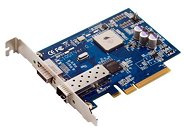- Joined
- Oct 9, 2007
- Messages
- 47,670 (7.43/day)
- Location
- Dublin, Ireland
| System Name | RBMK-1000 |
|---|---|
| Processor | AMD Ryzen 7 5700G |
| Motherboard | Gigabyte B550 AORUS Elite V2 |
| Cooling | DeepCool Gammax L240 V2 |
| Memory | 2x 16GB DDR4-3200 |
| Video Card(s) | Galax RTX 4070 Ti EX |
| Storage | Samsung 990 1TB |
| Display(s) | BenQ 1440p 60 Hz 27-inch |
| Case | Corsair Carbide 100R |
| Audio Device(s) | ASUS SupremeFX S1220A |
| Power Supply | Cooler Master MWE Gold 650W |
| Mouse | ASUS ROG Strix Impact |
| Keyboard | Gamdias Hermes E2 |
| Software | Windows 11 Pro |
As digital files grow larger in size, the amount of data being transferred over networks is ever increasing. Today, Thecus Technology is pleased to announce the C10GT 10 Gbps Ethernet PCI-e Adapter. Featuring lightning-fast transfer speeds, dual cable connectivity, and simple installation and setup, the C10GT is a high-speed 10Gb ready network card designed to help users affordably take full advantage of the new upcoming 10Gb Ethernet standard.
The C10GT is a very capable and feature-packed network adapter. Powered by the enterprise-class Tehuti Luxor TN3020-D processor, the C10GT delivers efficient high-bandwidth access to server and storage applications, while requiring relatively low power for operation. Another standout feature of the C10GT is its dual cable interface, which features one CX4 port and one SFP+ port - perfect for accommodating both copper and fiber optic cabling.

On the software side, the C10GT is an extremely flexible device which is easily integrated into almost any network environment. It is compliant with IEEE 802.3ae, IEEE 802.3ak, and IEEE 802.1q VLAN standards, and supports a multitude of widely-adopted operating systems, including Windows Server 2003, Windows Server 2008 / 2008 R2, Windows XP, Windows Vista, and Linux. The C10GT is also compatible with the Windows Management Interface (WMI), allowing administrators to easily manage both local and remote computers.
This full-height PCI-e adapter is easily installed in both PCI Express x4 and x8 slots, and can even be used to upgrade the following Thecus NAS devices to 10Gb Ethernet capability:
For more information on the C10GT, check out this page.
View at TechPowerUp Main Site
The C10GT is a very capable and feature-packed network adapter. Powered by the enterprise-class Tehuti Luxor TN3020-D processor, the C10GT delivers efficient high-bandwidth access to server and storage applications, while requiring relatively low power for operation. Another standout feature of the C10GT is its dual cable interface, which features one CX4 port and one SFP+ port - perfect for accommodating both copper and fiber optic cabling.

On the software side, the C10GT is an extremely flexible device which is easily integrated into almost any network environment. It is compliant with IEEE 802.3ae, IEEE 802.3ak, and IEEE 802.1q VLAN standards, and supports a multitude of widely-adopted operating systems, including Windows Server 2003, Windows Server 2008 / 2008 R2, Windows XP, Windows Vista, and Linux. The C10GT is also compatible with the Windows Management Interface (WMI), allowing administrators to easily manage both local and remote computers.
This full-height PCI-e adapter is easily installed in both PCI Express x4 and x8 slots, and can even be used to upgrade the following Thecus NAS devices to 10Gb Ethernet capability:
- N7700PRO
- N7700+
- N8800PRO
- N8800+
For more information on the C10GT, check out this page.
View at TechPowerUp Main Site





